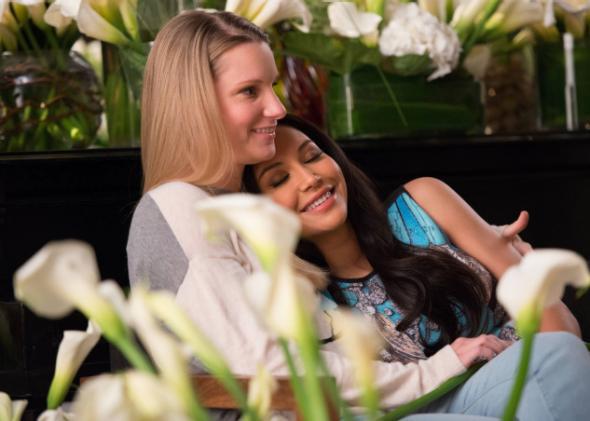Thank goodness for The L Word and Portia de Rossi. Before the mid-aughts, when the former premiered and the latter came out of the closet, the pernicious stereotype of the mannish, poorly dressed lesbian dominated the public perception. But, thanks to the hyperfeminine “new lesbian” of the 2000s, at long last feminine lesbians began to be represented in the media, helping them in their long, ongoing struggle against the dreaded femme invisibility. In this exciting new era, lesbian women grow up knowing that rather than being largely immune to society’s punitive and unrealistic standards of female beauty, they, too, can spend their lives in pursuit of them. Hoo. Ray.
Don’t get me wrong—it’s great that we’re being represented at all. The very existence of a show like The Fosters (with a fully realized lesbian couple at the heart of things) is wonderful. I grew up in the 1990s, and if someone had tried to make a list of the top 25 lesbian characters on television in 1991, when Sandra Bernhardt first appeared on Roseanne, or in 1997, when Ellen came out, they’d have come up 23 or 24 lesbians short. But, even back in the day, the gay women who showed up on screens tended to be feminine ones. As the ranks of TV femmes grow ever larger, it’s starting to get just a little bit annoying for a proud butch lesbian like me.
The harm done to women and girls by the media’s unrealistic standards of female beauty has been pointed out, harped on, and railed against by better women than I for as far back as I can remember. So I understand why most of the lesbians on television are conventionally pretty girls—most of the women on TV are, and it seems that gay women are no exception. But if there was any benefit to our long years of invisibility, perhaps it was that we were able to gain some measure of immunity from the standards and expectations imposed on other women. The triumph of the media-friendly femme chips away at the one advantage we once had: the freedom to define ourselves without the fetters of the mass culture telling us how to look, dress, and comport ourselves.
Somehow we’ve even come to a point where it’s easier to think of straight butch TV characters—Game of Thrones’ Brienne of Tarth, Coaches Shannon Beiste and Sue Sylvester of Glee, and Battlestar Galactica’s Starbuck, to name a few, than it is to come up with an actual butch lesbian. (OK, there’s Big Boo on Orange Is the New Black, but that’s it.) Meanwhile, the Fosters are femme, Arizona and Callie are femmer, and Santana and Brittany are the femmest. Even Emily’s girlfriend Paige McCullers on Pretty Little Liars grows more feminine by the episode.
I blame a lack of imagination in Hollywood, because butch ladies could make great characters. A blunt-spoken butch could easily fit the archetype of a fool who speaks truth to power. A wisecracking butch would make for an ideal sidekick. A hypercompetitive butch would be a fun villain, while a sensitive butch could be a hero. The only thing standing in the way is the complete and total inability of Hollywood to see uses for women as anything other than eye candy. Luckily for us, that’s sure to fall by the wayside any day now.
